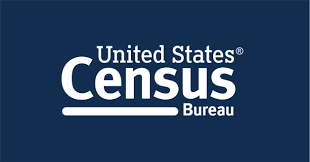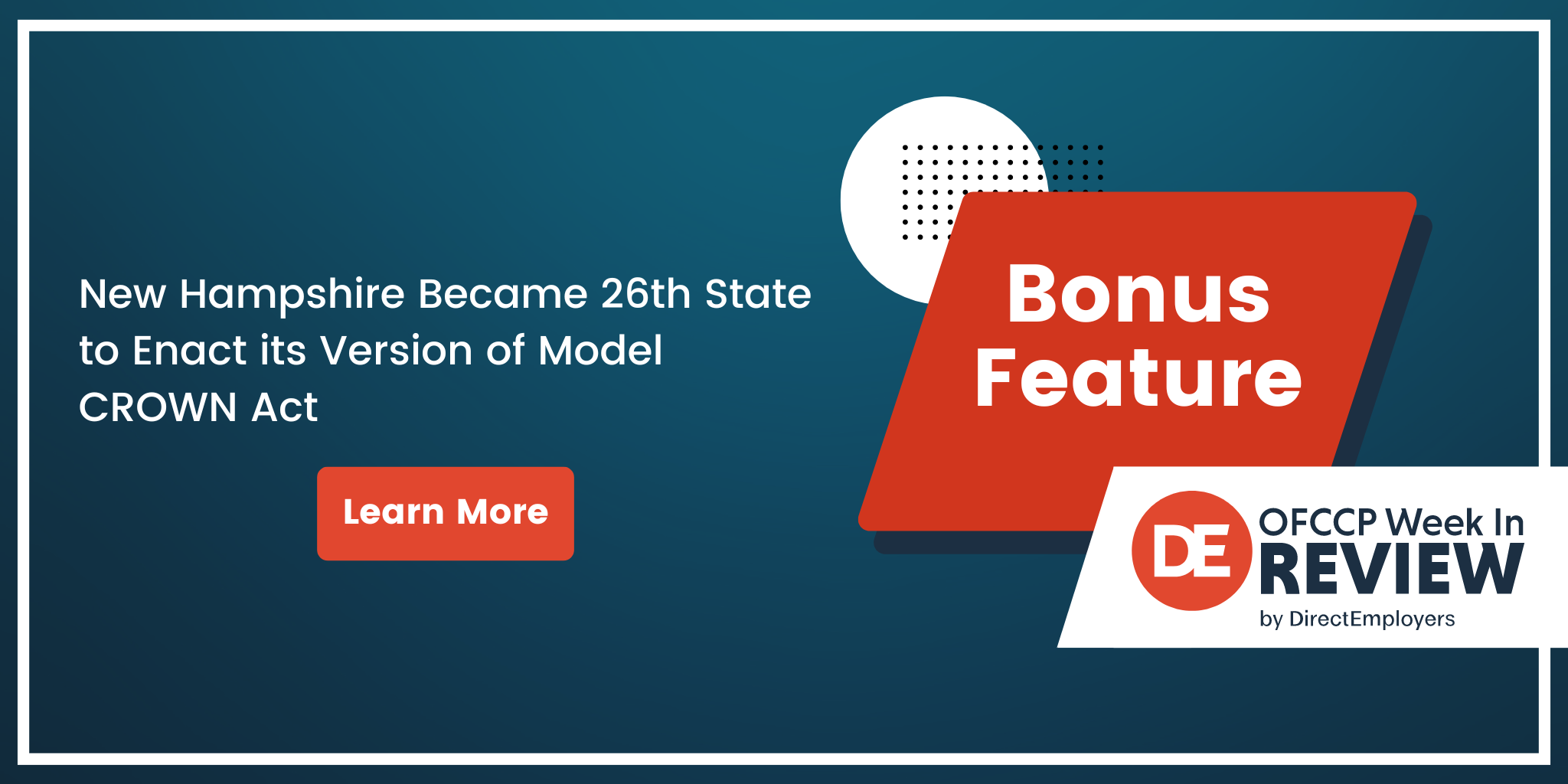 The DE OFCCP Week in Review (WIR) is a simple, fast and direct summary of relevant happenings in the OFCCP regulatory environment, authored by experts John C. Fox, Candee J. Chambers and Cynthia L. Hackerott. In today’s edition, they discuss:
The DE OFCCP Week in Review (WIR) is a simple, fast and direct summary of relevant happenings in the OFCCP regulatory environment, authored by experts John C. Fox, Candee J. Chambers and Cynthia L. Hackerott. In today’s edition, they discuss:
- New Hampshire Became 26th State to Enact its Version of Model CROWN Act
- Second Opportunity to Comment on Proposed Resurrection of Construction Contractor Monthly (CC-257) Employment Utilization Reports
- U.S. Census Bureau Requested Public Comments on ACS Timeline for Implementing Updated Directive on Race & Ethnicity Data Standards
- Looking Ahead: Upcoming Date Reminders
Wednesday, July 3, 2024: New Hampshire Became 26th State to Enact its Version of Model CROWN Act
Model CROWN Act Ties Natural Hair Texture & Protective Hairstyles to Race/Ethnicity Discrimination Protections
EEOC Enforcement Stances Similar to Model CROWN Act
No Current Legal Consensus on Whether Title VII’s Race Discrimination Prohibition Covers Natural Hair Texture/Related Protective Styles

New Hampshire became the 26th U.S. State to enact its version earlier this month. Specifically, Governor Christopher Sununu (R) signed into law HB 1169: Creating a private cause of action for discrimination based on hairstyles relative to a person’s ethnicity.
Readers may recall our early April story and DE Under 3 video about how an Equal Employment Opportunity Commission (“EEOC”) Consent Decree illustrated that agency’s enforcement stance regarding natural hair texture and race discrimination. In that story, we discussed the current state of federal law on this issue. We also noted that (then) roughly 23 states (and multiple localities) have enacted this legislation [the CROWN Act], in various forms, some of which do not conform completely with the model version of the measure.
EEOC Enforcement Stance
In our April 4, 2024 story, we reported on an EEOC statement announcing a recent Consent Decree. Importantly, the EEOC explicitly stated that natural hair texture counts as an “immutable characteristic of race” covered by Title VII. Accordingly, the Commission concluded that prohibiting a Black employee from wearing her hair in its natural state constitutes race discrimination in violation of Title VII. In the case before the Commission, the employee was female, but this enforcement stance would apply regardless of gender.
We also explained that, currently, there is no legal consensus as to whether Title VII’s prohibition on race discrimination covers natural hair texture. Meanwhile, there is a movement to amend federal law to have the definition of race discrimination in Title VII not only explicitly include natural hair texture but also to protect certain hairstyles.
Protective Hairstyles
The hairstyles covered under the model CROWN Act are those designed to protect the health of naturally curly hair. Those styles may include braids, locs, twists or bantu knots. The Texas CROWN Act website offers this definition of protective hairstyles:
“A protective hairstyle is a style that tucks the ends of the hair away from being exposed to damaging agents such as sun, heat, and constant manipulation.”
Updated State Tally
Friday, July 12, 2024: U.S. Census Bureau Requested Public Comments on ACS Timeline for Implementing Updated Directive on Race & Ethnicity Data Standards

Comments are due by August 12, 2024, and may be submitted here or here.
How We Got Here
On March 28, 2024, the White House Office of Management and Budget (“OMB”) released its finalized revisions to its SPD 15 (“2024 SPD 15”). That Directive contains common definitions to allow the federal government to compare race and what OMB calls “ethnicity” data across federal agencies. Federal contractors use SPD 15 primarily to identify the races and national origins of applicants and employees for use in Affirmative Action Plans and discrimination analyses. The finalized revisions updated the previous 1997 version of SPD 15 (“1997 SPD 15”).
OMB directed the applicable federal agencies to implement program changes as soon as possible but no later than March 28, 2029. (Our story here details those changes).
Proposed Timeline Details
Apart and independently from a 2027 ACS implementation of the 2024 SPD 15, the Census Bureau is also considering using bridging techniques, or crosswalking, to produce a limited set of experimental data products earlier than the schedule outlined below. If deemed feasible, these early experimental data products would likely be a subset of tables from the 5-year data products that would reflect data from 2022-2026, crosswalked with the updated race and ethnicity data standards.
The Census Bureau has conducted an assessment of what would be necessary to implement the 2024 SPD 15 in the ACS in either: a) the 2026 ACS with dissemination of data products to then begin in 2027, or b) the 2027 ACS with dissemination of data products to then begin in 2028. This assessment considered multiple factors such as:
- The amount of additional time needed for ACS activities to ensure accurate implementation. The most challenging tasks include revising and testing procedures for processing data and developing updated data products.
- Necessary scope and schedule changes for competing ongoing high-priority projects. The Census Bureau has a number of critical data modernization projects underway that are expected to use many of the same resources needed for implementation of the 2024 SPD 15 in the ACS.
- The need and timing for additional expert resources. Implementing the 2024 SPD 15 in the ACS requires the availability of dedicated resources with subject matter expertise.
- When and how to obtain external stakeholder feedback on Census Bureau implementation plans. Transparent engagement with stakeholders is highly valued and will inform deliberations.
Implementing the 2024 SPD 15 as quickly as possible must be balanced against the risks of major errors, the Bureau noted. Information gathered through the requested public comments will allow the Census Bureau to update this assessment to include additional costs, risks, and benefits faced by non-Federal users of ACS data.
Timeline for 1-Year and 5-Year Data
The Bureau’s plan to implement the updated standards in 2027 would mean that the first ACS 1-year estimates under the updated standards would be released in September 2028 for the 2027 ACS 1-year data. The first 5-year estimates produced solely using the data collected under the 2024 SPD 15 would be available in the 2027-2031 ACS 5-year data, scheduled for release in December 2032. Should a determination be made to instead implement the updated standards in 2026, these release dates would be moved up by one year. For example, the first ACS 1-year data using the updated standards would be released in September 2027, and the first ACS 5-year estimates would be released for the 2026-2030 ACS data in December 2031. Note that this alternative schedule would align the 5-year ACS estimates with the 2030 Decennial Census data.
Crosswalking Plan
Once the ACS program begins collecting data using the updated race and ethnicity data standards, the data produced in the 5-year estimates will be crosswalked to the updated race and ethnicity groups until there are five years of data collected in the updated format. For example, the 2023-2027 ACS 5-year estimates would contain data collected in years 2023 through 2026 using the 1997 SPD 15 and data collected in 2027 using the 2024 SPD 15. In those 2023-2027 ACS 5-year estimates, data collected in 2023 through 2026 would be crosswalked to the updated race and ethnicity categories, and data products would comply with the 2024 SPD 15. Crosswalking procedures would be required for all data collected under the 1997 SPD 15 for each 5-year file produced until there are a full 5 years of data available that have been collected under the 2024 SPD 15, as follows:
- 2023-2027 5-Year Estimates: Crosswalking required for years 2023, 2024, 2025, 2026
- 2024-2028 5-Year Estimates: Crosswalking required for years 2024, 2025, 2026
- 2025-2029 5-Year Estimates: Crosswalking required for years 2025, 2026
- 2026-2030 5-Year Estimates: Crosswalking required for years 2026
- 2027-2031 5-Year Estimates: No crosswalking required
This proposed data release schedule will impact all data products that are cross-tabulated by race and ethnicity.
Looking Ahead:
Upcoming Date Reminders
We added two NEW items to our calendar this week:
March 11, 2024: Previous effective date of NLRB’s Final Rule on Standard for Determining Joint-Employer Status under the NLRA (per U.S. District Judge’s order; original February 26, 2024, effective date extended); On March 8, 2024, a U.S. District Judge vacated this Final Rule and on May 7, 2024, the NLRB filed a Notice of Appeal – stay tuned for further developments
July 17, 2024: Deadline for comments on OFCCP’s Proposed Changes to its Construction Compliance Review Scheduling Letter, Itemized Listing, and Construction Contract Award Notification Requirement Form (see here for details on the proposed changes)
July 18, 2024 (2:00 pm – 3:30 pm ET): DE Masterclass Employment Law Roundtable | How To Properly Prepare For and Defend an OFCCP Audit
July 23, 2024: Comments due on the FAR Council’s proposal to reinstate a requirement for federal contractors to report executive compensation and first-tier subcontract awards
NEW August 8, 2024: Deadline for comments on OFCCP’s modified proposal to Resurrect, with Changes, Monthly Employment Utilization Report for Construction Contractors
NEW August 12, 2024: Comments due on U.S. Census Bureau’s “American Community Survey Timeline for Implementing Updated 2024 Race and Ethnicity Data Standards.”
August 20, 2024: Comments due on US DOL VETS’ Request for Information on “Black Veterans and Good Jobs”
August 29, 2024 (11:00 – 5:30 EST): US DOL WHD online seminar on prevailing wage requirements for federally-funded construction projects; register here
September 4, 2024: Scheduled effective date for Federal Trade Commission Final Rule banning most non-compete agreements
September 2024: U.S. NLRB’s target date for its Final Election Protection Rule (RIN: 3142-AA22)
September 2024: OFCCP’s current target date for its Final Rule on “Technical Amendments” to Update Jurisdictional Thresholds & Remove Gender Assumptive Pronouns (RIN: 1250-AA16)
September 2024: U.S. DOL WHD’s target date to publish an NPRM on “Employment of Workers With Disabilities Under Special Certificates” (Subminimum Wage Rule) (RIN: 1235-AA14)
October 2024: EEOC’s target date for proposal to amend its regulations regarding the electronic posting of the “Know Your Rights” Poster (RIN: 3046-AB29)
November 5, 2024: Federal Congressional and Presidential Election
December 2024: EEOC’s target date to publish its NPRM to amend its regulations on exemptions to certain recordkeeping and reporting requirements (RIN: 3046-AB28)
December 2024: U.S. OSHA’s current target date to publish its Final Rule on Occupational Exposure to COVID-19 in Healthcare Settings (RIN: 1218-AD36)
January 1, 2025: Second effective date for US DOL WHD’s Final Rule on Defining and Delimiting the Exemptions for Executive, Administrative, Professional, Outside Sales, and Computer Employees (Overtime Rule); the standard salary level necessary for exemption – i.e., eligible for overtime pay – will increase from $43,888/year to $58,656/year and the highly compensated employee threshold will increase from $132,964/year to $151,164/year
January 2025: EEOC’s target date to publish its NPRM to amend its regulations at 29 CFR Part 1602 to provide for a pay data collection (RIN: 3046-AB15)
May 21 – May 23, 2025: DEAMcon25 in Scottsdale, Arizona
May 2025: OFCCP’s current target date for its Notice of Proposed Rulemaking to “Modernize” Supply & Service Contractor Regulations (RIN: 1250-AA13)
May 2025: FAR Council’s current target date for its Final Rule to Prohibit TikTok [or any successor application or service developed or provided by ByteDance Limited] on Federal Government Contractor Devices (RIN: 9000-AO58); the Interim Rule is here
SUBSCRIBE.
Subscribe to receive alerts, news and updates on all things related to OFCCP compliance as it applies to federal contractors.
OFCCP Compliance Text Alerts
Get OFCCP compliance alerts on your cell phone. Text the word compliance to 18668693326 and confirm your subscription. Provider message and data rates may apply.



Tuesday, July 9, 2024: Second Opportunity to Comment on Proposed Resurrection of Construction Contractor Monthly (CC-257) Employment Utilization Reports
OFCCP Made Several Revisions to its Initial Proposal
To download the proposed CC-257 Form and instructions, as modified for publication in the 30-day Notice, click here.
Comments on the 30-day Notice are due by August 8, 2024. You may submit them here, here, or here.
Abstract
In its corresponding abstract statement on RegInfo.gov (click “Abstract/Justification”), OFCCP stated:
OFCCP cited Executive Order 11246 (“EO 11246”) as the legal authority for this information collection.
60-Day Notice Proposal
In the 60-day Notice, the agency explained that “covered construction contractors previously submitted [Form CC-257] to OFCCP on a monthly basis and [it] included information on employee work hours by race/ethnicity, gender, and trade in the covered area.” You may download a copy of the previous, defunct version of the form here. OFCCP discontinued the use of Form CC-257 on December 8, 1995 (during the Clinton Administration).
Our earlier story on the 60-day Notice pointed out that since the Clinton OFCCP discontinued these reports almost 30 years ago, no other Republican or Democrat Administration since then has thought the CC-257 reports worthwhile and all thought them too expensive for construction contractors and for OFCCP itself to process. Indeed, thousands of them used to monthly stack up in agency hallways in boxes, unread (back in the day when contractors mailed paper reports). (See also our corresponding DE Under 3 video discussing the 60-day Notice.)
The text of the 60-day Notice itself simply stated that, under the proposed changes, construction contractors would “provide information on employee work hours and employee count by race/ethnicity, gender, and trade in the covered area.” A corresponding 17-page 60-day Supporting Statement, attached to the Notice and posted on Regulations.gov, provides more detail. See our previous story on the 60-day Notice for details on that version of the proposal.
The comment period on the 60-day Notice closed on April 23, 2024, with 12 comments submitted.
30-Day Notice Modified Proposal
As with the 60-day Notice, the 30-day Notice provided little substantive detail on the changes to the proposal that OFCCP made with the 30-day Notice. Rather, the agency put those details into its 30-day Supporting Statement. That new 30-page Supporting Statement, appeared on RegInfo.gov on July 10, the day after OFCCP published the 30-day Notice in the Federal Register. It is dated June 27, 2024.
OFCCP addressed in detail the 12 comments submitted in response to the 60-day Notice on pages 14-26 of the 30-day Supporting Statement.
Below, we discuss only the revisions to the proposed changes as described in the 30-day Supporting Statement. See our earlier story on the 60-day Notice for details on the changes that OFCCP proposed in the initial 60-day Notice.
On page 14 of the 30-day Supporting Statement, OFCCP summarized the changes for the 30-day Notice. Those changes are as follows:
Added another classification: “non-apprenticed laborers or helpers” (detailed on pages 23 and 27 of the 30-day Supporting Statement). OFCCP asserted that adding this classification will allow contractors to better account for employees who are not part of construction trainee or apprenticeship programs. OFCCP discussed this change in detail on pages 23 and 27.
Clarified the reporting period and due date information in the instructions (detailed on pages 20-21 of the 30-day Supporting Statement). OFCCP discussed this change in detail. The agency clarified that each report would be “due on the 15th day of the month following the end of the reporting period.” If this date falls on a weekend or Federal holiday, the report would be due on the following business day.
OFCCP also proposed modifying the language describing the reporting period as follows:
Added information in the instructions for accounting for non-binary employees (detailed on pages 21-22 of the 30-day Supporting Statement). In response to the 60-day Notice public comments, OFCCP proposed added instructions that align with the guidance in the Employer Information Report (EEO-1 Report). Specifically, the instructions would allow contractors to voluntarily report data for non-binary employees in the “comments” section of the report. See Item 16 in the proposed CC-257 Instructions. According to the OFCCP, this approach will provide a way for contractors to account for non-binary employees, while also ensuring consistency across reporting requirements.
Added specific language to the certification requirement (detailed on page 18 of the 30-day Supporting Statement). While the 60-day proposal already required the official to certify the information contained in the form, the added language would require the signing official to certify that the information, including any workforce demographic data, provided in the report is correct and true to the best of their knowledge and was prepared in conformity with the directions set forth in the form and accompanying instructions. OFCCP pointed out that it uses similar certification language in other reports such as the EEO-1 Report.
Updated the submission method in the instructions (detailed on page 24 of the 30-day Supporting Statement). OFCCP maintained that electronic submission (apparently via a new OFCCP portal – see the second paragraph of the proposed CC-257 Instructions) “remains the preferred method for submitting the report.” However, to address the public comments in response to the 60-day Notice, OFCCP stated that “one of the electronic submission methods will include an Excel version of the form that contractors can upload as an email attachment and provide to the agency. To minimize burden, the form will also allow the user to insert certain profile information only once.”
Other minor adjustments (discussed on page 14 of the 30-day Supporting Statement). The OFCCP “reordered some of the fields included in the 60-day proposal” and made “nonsubstantive language changes.”
Enforcement. On page 18 of the 30-day Supporting Statement, the OFCCP noted that it: